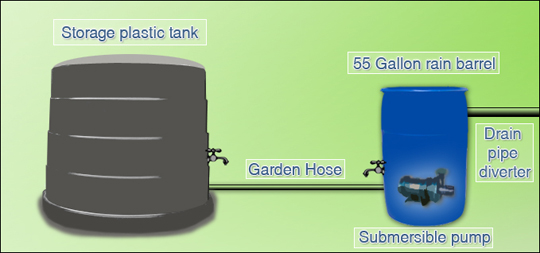
Collecting RainWater

Collecting rainwater in rain barrels or rainwater harvesting as it's often called,has existed for almost 4000 years,actually since ancient Rome.
It all boils down to being self sufficient,getting into the habit of collecting rainwater will help reduce the demand for tap water from your local municipality.
Rainwater harvesting is not just a matter of saving money or lowering the water bill, but also a matter of conserving one of the most precious sources on earth.
If King Mesha of Moab won his war in his quest for land east of Jordan due to making reservoirs for collecting rainwater,the same water that allowed him to survive through moments of drought or if ancient Rome practiced rainwater harvesting,then there's no reason why we shouldn't be able to do the same in 2010.
Collecting rainwater in a rain barrel is the best way to go as far as not only saving water, but also being conscious that tap water can be left for drinking and taking a shower.
You don't need to use tap water to water the garden, top up the pool or wash the car in the summer,use rain water instead just like ancien Rome did a very long time ago.
Rain water or soft water is perfect for the garden, conserve water during hot summer months, washing the pavement, tools, windows. Also when you wash your car, it won't leave any spots when you rinse it.
Collecting rainwater does not contain any chlorine, lime, calcium or fluoride in water as in tap water. The chlorine contained in municipal water kills bacteria, making it safe for us to drink it.
Although when applied to your lawn or gardens, these additives diminish the already existing bacteria contained in the soil and can damage plants.
Calculating rainwater collection
To determine how much rain water you can expect to collect from your rooftop, you need to calculate the rainwater catchment area, in other words, you need to calculate the surface area of your rooftop to determine how much water you're gonna receive.
The amount of rainwater collection depends on three factors :
The amount of rainwater in a given downpour, the size of your catchment area and the maximum capacity of your storage device, in this case a standard rain barrel.
By looking at the average rainfalls in your area, you can figure out how much rainwater you can expect to collect per year and weather that will meet your family's water needs.
An average household with newer plumbing fixtures such as 1.6 gallon per flush toilets and 2.5 gallon per minute showerheads uses roughly 55 gallons per person. per day.
Rainwater collection from roofs can be calculated using the following formulas :
1 inch of rain on a 1000 sq feet roof will give you 623 gallons of water or 1 millimeter of rain on a 1 square meter surface will yield 1 Litre of water.
Remember that actual rainfall amounts fluctuate with the seasons, while households needs remain reasonably steady.
If you would like to have a more visual understanding on collecting rainwater, you can always do a square foot calculation to determine exactly the amount of rainwater your roof will yield.
A rainfall usually is calculated in inches using a tool called a rain guage or can be obtained by consulting historical records in an almanac or local weather stations and other meteorological and climatic sources.
You might also want to find out the annual rain fall in you state,province or country.
Rainwater Harvesting
You have to keep in mind how much rain water you want to collect, since their are various methods to collecting rain water.
You can have several barrels in a rain chain with a 3/4" garden hose in between them with an overflow device OR you can simply have a much larger plastic tank connected with a garden hose going to your standard 55 gallon barrel over you're gutter.
So if the excess rain water is not going into another rain barrel garden or flower bed, then you can have a submersible pump inside your standard 55 gallon rain barrel with an automatic float switch so when excess water is detected, it will just pump it out and all that water will go into a plastic tank.
Here's a drawing explaining this :

This is the same principal as for example the standard sump pump we all have in our house's. For example, after a huge rainfall, the sump pump will start working and pump the water out so the house doesn't get flooded. Same principal with the rain barrel, it doesn't take much to fill it.
Like the picture above,you might want a large plastic tank connected to a smaller water barrel,so when the standard water barrel fills up,the excess water will go into the plastic tank.


